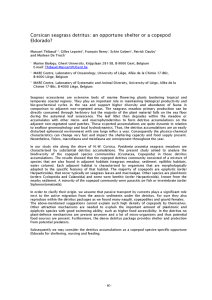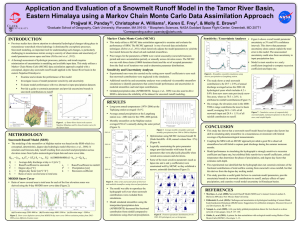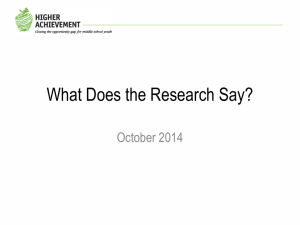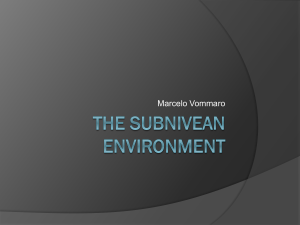HBVmodel09 - IARC Research - University of Alaska Fairbanks
advertisement
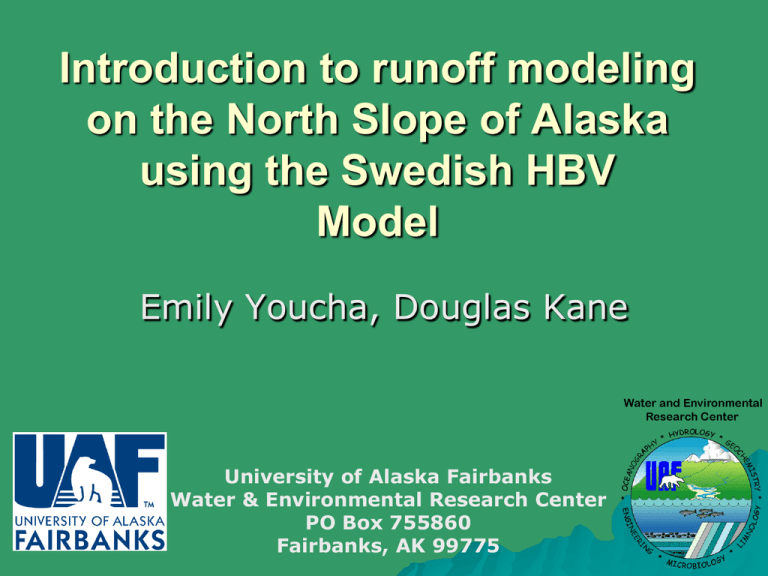
Introduction to runoff modeling on the North Slope of Alaska using the Swedish HBV Model Emily Youcha, Douglas Kane University of Alaska Fairbanks Water & Environmental Research Center PO Box 755860 Fairbanks, AK 99775 Objective Use existing meteorological datasets and develop HBV model parameters to simulate runoff in both small and large North Slope Basins Kavik Kuparuk Sag Upper Kuparuk Approach Begin runoff simulations on North Slope streams with abundance of data Imnaviat Cr, 2.2 km2 (1985-present) Upper Kuparuk River, 146 km2 (1993present) – Putuligayuk River, 417 km2 (1970-1979, 1982-1986, 1999-2007) – Kuparuk River, 8140 km2 (1971present) Develop parameter sets and apply to other rivers (ungauged?) HBV Model Rainfall-runoff model, commonly used for forecasting in Sweden Developed by Swedish Meteorological and Hydrological Institute Semi-distributed conceptual model – Divide into sub-basins – Precipitation and temperature may be spatially distributed by applying areal-based weights to station data – Use of elevation and vegetation zones Required data inputs (hourly or daily) include: – Precipitation (maximum end-of-winter SWE and summer precipitation) – Air temperature – Evapotranspiration (pan evaporation or estimated) daily or monthly Routines include: – – – – Snow Soil Moisture Accounting Response Transformation HBV Routines and Input Data Snow Routine Inputs: Precipitation, Temperature Outputs: Snowpack, Snowmelt Soil Moisture Routine Inputs: Potential Evapotranspiration, Precipitation, Snowmelt Outputs: Actual Evapotranspiration, Soil Moisture, Ground-Water Recharge Response Routine Input: Ground-Water Recharge/Excess soil moisture Output: Runoff, Ground-Water Levels Transformation Routine Input: Runoff Simulated Runoff SMHI Soil Moisture Routine Routines and Parameters: Snow: 4 + parameters Degree-day method: Snowmelt = CFMAX * (T –TT) CFMAX=melting factor (mm/C-day) TT=threshold temperature (C) (snow vs. rain) CFR=refreezing factor to refreeze melt water WHC=water-holding capacity of snow (meltwater is retained in snowpack until it exceeds the WHC) recharge Soil Moisture Accounting : 3+ parameters Modified bucket approach Shape coefficient (BETA) controls the contribution to the response function (runoff ratio) Q0=K0 * (SZ- UZL0) UZL0 Limit of potential evapotranspiration (LP), the soil moisture value UZL1 Response Routine SZ Q1=K1 * (SZ- UZL1) above which ET reaches Potential ET Maximum soil moisture (FC) Response 4+ parameters Transforms excess water from soil moisture zone to runoff. Includes both linear and non-linear functions. Upper reservoirs represent quickflow, lower reservoir represent slow runoff (baseflow). Lakes are considered as part of the lower reservoir. Lower reservoir may not be used (PERC parameter is set to zero due to presence of continuous permafrost). Transformation/Routing To obtain the proper shape of the hydrograph, parameter= MAXBAS (/d) Q2=K3 * SZ Recharge: input from soil routine (mm/day) Runoff SZ: Storage in zone (mm) UZL:Threshold parameter Ki: Recession coefficient (/day) Qi: Runoff component (mm/day) Modified from Siebert, 2005 SMHI Manual, 2005 Transformation Routine HBV Calibration Qsim Qobs 1 Qobs Qobs 2 2 Each model routine has parameters requiring model calibration – over 20 parameters, and may be varied throughout the simulated period (i.e. spring vs. summer) Explained variance (observed vs. simulated) is the NashSutcliffe (1970) model efficiency criterion good model fit is Refficiency=1. Also looked at accumulative volume difference and visually inspect the hydrograph. Used the commercially available HBV software to manually calibrate the model by trial and error We tried HBV automated calibration to estimate parameters (Monte Carlo procedure using “HBV-light” by Siebert, 1997). Produced many different parameter sets that would solve the problem. Many parameters were not well defined Most of the time, model validation results not very good. GUI – easy to use and view results quickly (sort of) Observed Hydrographs for Imnaviat and Upper Kuparuk: 1996, 1999, 2002, 2005 130 4.0 120 Imnaviat Creek - Observed Flow 3.5 3.0 110 Q1996 Q1999 Q2002 Q2005 100 90 80 3 Flow (m /s) 3 Flow (m /s) 2.5 2.0 1.5 Upper Kuparuk - Observed Flow Q1999 Q1996 Q2002 Q2005 Snowmelt Summer 70 60 50 40 1.0 Summer Snowmelt 30 20 0.5 10 0.0 120 140 May 160 June 180 200 July 220 August Day of Year 240 260 September 280 0 120 140 May 160 180 June 200 July Day of Year 220 August 240 260 September 280 HBV Parameter Example: Upper Kuparuk, 21 parameters to calibrate! 1996 1999 2002 2005 Snow Routine TT (C) 1 1 1 1 SFCF 1 1 1 1 WHC 0.1 0.1 0.1 0.1 4 4 4 4 0.05 0.05 0.05 0.05 PCORR 1 1 1 1 RFCF 1 1 1 1 PCALT 0.1 0.1 0.1 0.1 TCALT 0.6 0.6 0.6 0.6 CFMAX (mm/C-d) CFR Soil Moisture Routine BETA spring 0.2 0.2 0.2 0.2 BETA summer 0.2 0.2 0.2 0.2 FC (mm)spring 10 10 10 10 FC (mm)summer 50 50 50 50 LP 0.9 0.9 0.9 0.9 ECALT 0.1 0.1 0.1 0.1 CFLUX 1 1 1 1 Response Routine k0 (/d) spring 0.4 0.4 0.4 0.4 k0 (/d) summer 0.9 0.9 0.9 0.9 k1 (/d) spring 0.1 0.1 0.1 0.1 k1 (/d) summer 0.5 0.5 0.5 0.5 k3 (/d) spring 0.06 0.06 0.06 0.06 k3 (/d) summer 0.09 0.09 0.09 0.09 UZL0 (mm) spring 40 40 40 40 UZL0 (mm) summer 30 30 30 30 UZL1 (mm) spring 10 10 10 10 0 0 0 0 UZL1 (mm) summer PERC Transformation Routine Preliminary Automated Calibration Results (Monte Carlo Procedure) Dotty plots – look for parameters that are well defined Automated Calibration Results (Monte Carlo Procedure) Snowmelt 2002 Snowmelt Parameters 1.00 0.95 0.90 0.85 0.80 0.75 Upper Kuparuk Spring Snowmelt 2002 Automated Calibration Runoff (mm/hr) 0.4 0.3 0.2 1.00 0.95 0.90 0.85 0.80 0.75 2 0.5 Qobserved P37 P65 P99 P112 P116 P129 P132 P144 P155 P212 -1 1.00 0.95 0.90 0.85 0.80 0.75 1 5/16 5/26 2002 6/5 6/15 1 2 2 3 4 5 Snowfall Correction Factor SFCF:0.5-0.75 0.75 1.00 1.25 1.50 Refreezing Factor 1.00 0.95 0.90 0.85 0.80 0.75 0.0 0 Snowmelt Factor (mm/C-day) CFMAX: 1-2 1.00 0.95 0.90 0.85 0.80 0.75 0.1 5/6 Threshold Temperature (C) R 0.6 Upper Kuparuk 2002 Spring Period 0.04 0.06 0.08 Water Holding Capacity of Snow 0.0 0.2 0.4 0.6 20 0 3 10 5/16 5/31 6/15 6/30 7/15 Summer R-efficiency=0.42 Accum Diff = -18 mm Rel. Accum Diff =-19% 7/30 8/14 8/29 9/13 20 10 0 0 -10 90 80 R-efficiency=0.55 70 Accum Diff = 39 mm Rel. Accum Diff = 20% 60 50 40 Snowmelt 30 R-efficiency=-1.17 Accum Diff = 15 mm 20 Rel. Accum Diff = 49% 10 0 5/1 5/16 5/31 6/15 Qsimulated Qobserved Summer R-efficiency=0.56 Accum Diff = 23 mm Rel. Accum Diff = 15% 6/30 0 -20 -40 -60 -80 7/15 7/30 8/14 8/29 9/13 9/28 1999 20 Accum. Diff. Simulated Snow Observed Snow UKmet 40 20 9/28 1996 180 160 140 120 100 80 60 40 20 0 50 30 Snow Water Equivalent (mm) Snowmelt R-efficiency=0.85 Accum Diff = -4 mm Rel. Accum Diff =-3% 20 160 140 120 100 80 60 40 20 0 50 Accum. Diff. Simulated Snow Observed Snow UKmet 40 30 20 10 0 -10 15 100 Qsimulated Qobserved Accum Diff = -60 mm Rel. Accum Diff = -22% 80 60 40 20 0 5/1 Summer R-efficiency=0.25 Accum Diff = -83 mm Rel. Accum Diff = -37% Snowmelt R-efficiency=0.51 Accum Diff = 20 mm Rel. Accum Diff = -41 % 5/16 5/31 6/15 6/30 7/15 2002 7/30 8/14 8/29 9/13 9/28 10 R-efficiency=0.64 Accum Diff = 16 mm Rel. Accum Diff = 16% Qsimulated Qobserved 3 120 R-efficiency=0.29 3 Runoff (m /s) 30 0 5/1 Snow Water Equivalent (mm) Qsimulated Qobserved 40 Runoff (m /s) 3 Runoff (m /s) 40 R-efficiency=0.85 Accum Diff = -23 mm Rel. Accum Diff =-9% 60 Accum. Diff. Simulated Snow Observed Snow UKmet Accum. Diff. (mm) 40 60 Snowmelt R-efficiency=0.40 Accum Diff = 28 mm Rel. Accum Diff = 49% 5 0 5/1 5/16 5/31 6/15 6/30 Summer R-efficiency=0.82 Accum Diff = -13 mm Rel. Accum Diff = -28% 7/15 2005 7/30 8/14 8/29 9/13 9/28 Accum. Diff. (mm) 60 Snow Water Equivalent (mm) 80 Accum. Diff. (mm) 100 50 Runoff (m /s) 20 10 0 -10 -20 -30 -40 -50 -60 Simulated Snow Accum. Diff. Accum. Diff. (mm) Snow Water Equivalent (mm) 120 Summary Need an automated calibration procedure to develop unique parameter sets For Upper Kuparuk, model generally predicted timing of events (onset of snowmelt and timing of peak events). When it did not predict the proper timing, the model efficiency was poor. For Upper Kuparuk, model overpredicted snowmelt flow volume and underpredicted extreme peak runoff events during summer For both Upper Kuparuk and Imnavait, model did not predict the magnitude of peak flow Problems may be attributed to not using a long enough simulation period Many improvements are needed to increase the Nash-Sutcliffe model efficiency
